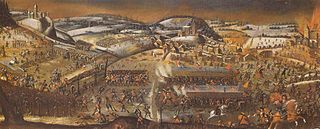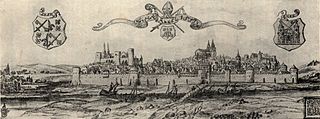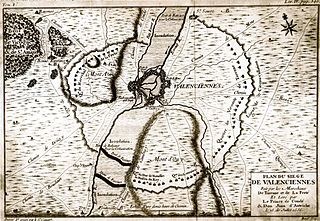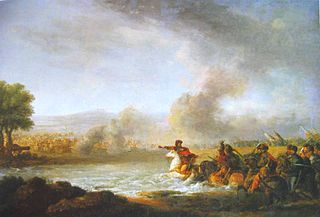 W
WThe Battle of Filipów was fought on October 22, 1656 between forces of the Polish-Lithuanian Commonwealth commanded by Field Lithuanian Hetman Wincenty Korwin Gosiewski on one side, and on the other allied Swedish and Brandenburg-Prussia forces commanded by Gustaf Otto Stenbock and Prince Georg Friedrich of Waldeck. The battle ended with victory for the Swedish-Brandenburg-Prussian troops.
 W
WThe Battle of Gołąb was fought on either February 18 or 19, 1656 between forces of the Polish-Lithuanian Commonwealth commanded by Stefan Czarniecki on one side, and on the other Swedish Empire's army commanded by Charles X Gustav. This battle was essentially a meeting engagement with Swedish troops arriving on the battlefield at different times. It is uncertain how many actually participated, and its actual date is disputed. Some sources, such as Polish-language Military Encyclopedia, claim it took place on February 18, while historian Leszek Podhorecki wrote that it was on February 19. The result was a Swedish victory.
 W
WThe Battle of Kłecko was fought on May 7, 1656, between forces of the Polish–Lithuanian Commonwealth commanded by Regimentarz Stefan Czarniecki and Jerzy Sebastian Lubomirski and a Swedish force commanded by prince Adolf Johan av Pfalz-Zweibrücken. The Polish–Lithuanian force was more than 12,000 strong and consisted mostly of cavalry, while the Swedes numbered around 7,000 artillery, infantry and cavalry. The Swedes achieved a tactical victory in that they escaped destruction by the Poles, who were unable to get to the Swedish army entrenched behind the Welnianka River, and various ditches and swamps. Swedish army lost 428 dead, while the Polish army sustained 70 dead and wounded, 2,000 dead or 3,000 dead, including 40 companions dead.
 W
WÇınar incident is the name of a 17th-century rebellion in the Ottoman Empire. It is also sometimes known as "The Event of the Vakvak", named after a mythical tree on which human beings grew, as an analogy to the corpses hung from trees in the aftermath of the rebellion.
 W
WThe First War of Villmergen was a Swiss religious war which lasted from 5 January until 7 March 1656, at the time of the Old Swiss Confederacy. On the one hand were the Protestant cities of Zürich and Bern, on the other the Catholic places in Central Switzerland. The Protestants tried to break the political hegemony of the Catholics, that had been in existence ever since the Second Kappel Landfrieden of 1531. The casus belli was the expulsion and execution of Protestants from the Schwyz commune of Arth. The Zürcher unsuccessfully besieged the Central Swiss-allied city of Rapperswil and thereby drove their forces together. The Bernese were defeated and repelled in the First Battle of Villmergen. The Third Landfrieden ended the conflict and restored the pre-war balance of power.
 W
W W
W W
WSiege of Riga by the Russian Army under Tsar Alexei Mikhailovich was the main event of the Russo-Swedish War. The fortifications of Riga consisted of a wall with ditch and 5 bastions around the old town. In 1652 Swedes had started construction of a new wall with 12 bastions around suburbs, but by 1656 the work had not been completed. The Russian vanguard consisting of the Vladimir v. Vizin reiters, Daniel Krafert infantry and Iunkmann dragoons approached Riga on August 20 and threw back the Swedes under count of Pärnu, Heinrich von Thurn into the city. Von Thurn was either killed, or captured in the action. The Swedes evacuated the suburbs and withdrew to the old town. A few days later, the main army under Tsar Alexei Mikhailovich arrived on the ships on the Duna River, and laid siege to Riga. The Russian army occupied three camps, two on the east bank of the Duna in Riga's suburbs, and a Corps under Ordyn-Nashokin on the west bank of the Duna, opposite the Kobrun entrenchment.
 W
WThe Siege of Warsaw took place between April 24 and July 1, 1656. Swedish Empire forces had occupied the Polish capital without fighting in early September 1655. In late April 1656, Poles and Lithuanians began the siege, with the purpose of recapturing their capital. They were successful, but later lost the city for a second time after a battle held on July 28–30, 1656.
 W
WThe Storm of Kokenhusen by the Russian Army under Tsar Alexei Mikhailovich was one of the first events of the Russo-Swedish War (1656–1658), a theater of the Second Northern War. On 14 August 1656 Russian troops stormed and captured the well-fortified town of Kokenhusen (Koknese) in Swedish Livonia
 W
WThe Third Battle of the Dardanelles in the Sixth Ottoman-Venetian War took place on 26 and 27 June 1656 inside the Dardanelles Strait. The battle was a clear victory for Venice and the Knights Hospitaller over the Ottoman Empire, although their commander, Lorenzo Marcello, was killed on the first day.
 W
WThe Siege of Valenciennes was fought between the Spanish troops commanded by Don Juan José de Austria against the French troops under Marshal Henri de la Tour d'Auvergne, Vicomte de Turenne, in the outskirts of the town in the Spanish Netherlands, during the Franco-Spanish War. It was the worst of only a few defeats that the French Marshal Turenne suffered in his long career campaigning and is regarded as Spain's last great victory of the 17th century.
 W
WThe Battle of Warka on April 7, 1656 between forces of the Polish-Lithuanian Commonwealth commanded by Stefan Czarniecki on one side, and on the other Swedish forces commanded by Frederick VI, Margrave of Baden-Durlach. Battle was fought for about two hours, ending in Polish victory. It was first Polish success in the open field since Swedish invasion of Poland in early summer 1655.
 W
WThe Battle of Warsaw was a battle which took place near Warsaw on July 28–July 30 [O.S. July 18–20] 1656, between the armies of the Polish–Lithuanian Commonwealth and Sweden and Brandenburg. It was a major battle in the Second Northern War between Poland and Sweden in the period 1655–1660, also known as The Deluge. According to Hajo Holborn, it marked "the beginning of Prussian military history".
 W
WSiege of Zamość was part of The Deluge, a series of campaigns in the Polish–Lithuanian Commonwealth, that took place in early 1656.